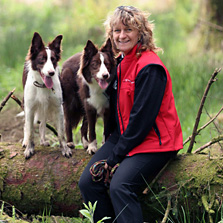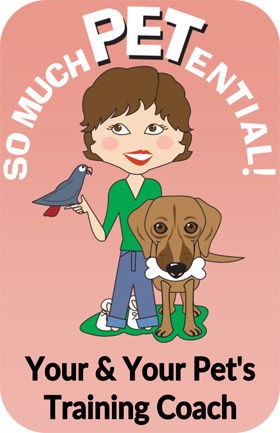dog training with positive reinforcement
TAGteaching Brings Out The Best In People
A few weeks ago, I was among the more than 500 dog trainers who convened on Dearborn, Michigan for three full days of non-stop learning about teaching animals in the most positive way. It was the Karen Pryor Academy ClickerExpo and it was phenomenal.
If you are unfamiliar, in its most simplified description, clicker training is a positive reinforcement based training strategy that involves ‘marking’ the very specific ‘wanted’ behavior with a click (or can be a word or other signal), that is immediately followed by a reinforcing consequence. Initially the animal learns to associate positive outcomes by  associating treats, tug time, or whatever other behavior strengthener you use with the sound of the clicker (classical conditioning), and then the animal learns to intentionally repeat a behavior in order to get that positive outcome (operant conditioning). I have information on in So Much PETential blog on clicker training basics.
associating treats, tug time, or whatever other behavior strengthener you use with the sound of the clicker (classical conditioning), and then the animal learns to intentionally repeat a behavior in order to get that positive outcome (operant conditioning). I have information on in So Much PETential blog on clicker training basics.
So, why am I writing about that here? Well, clicker training and operant teaching is not just about bringing out the best in our non-human companions. When thoughtfully used, it brings out the best in people too.
At the ClickerExpo, we were each given tickets and told to TAG someone when we saw them doing something good. When we TAGged someone, we entered his/her name and our own name in a bowl; and each day there were drawings for prizes. It was neat to see how that bowl filled during the weekend event. The more we practiced focusing on finding those reinforceable moments, the more of those moments we found.
Among the behaviors I was TAGged for were asking a woman if her dog would be okay with me walking past it (in the row of seats), helping a woman in a training exercise, and asking questions of one of the instructors.
I’ve got to say, each time that I was TAGged and each time I TAGged someone, it brought a smile to my face. Did TAGteaching make me learn more that weekend? Make me more open to meeting new people? Make everyone more positive with feedback and more welcoming as a whole?
Well, I can tell you that it was most definitely an environment where I strengthened my skills and added to my knowledge and I always knew I could walk into a room of people I did not know and feel welcome.
When it comes to animal training, I have written this reminder in my pet blog numerous times:
Remember, to teach in the most positive way, we need to empower our students
by allowing them to make their own choices – just making the choices we want them
to make the most valuable for them; we need to teach with clarity; we need to set
the learning environment up so that our student will be motivated to want to learn; and we need
to be willing to be patient, teaching those foundation skills and building difficulty only
as our student can continue to succeed.
But this does not just apply to training non-human animals. All of us perform better when we have clarity in purpose, are empowered and reinforced for good choices and good behavior.
My thought to leave you with is this: What are people around you doing that you would like to see more of? How will you let them know they did something great?
Preventing Dog Behavior Problems At Thanksgiving
NOTE: I have a new pet behavior blog located at http://www.SoMuchPETential.com/blog. Thanks!
Thanksgiving is quickly coming upon us. Oh to taste the turkey…stuffing…sweet potatoes…and pumpkin pie. I can hardly wait! So can Sam….and I bet your favorite pooch too.
So, let’s plan ahead. Sharing your meal with your guests AND your dog doesn’t necessarily have to be part of the holiday. The time to work on  teaching your dog new skills is now – not dinner time on November 22.
teaching your dog new skills is now – not dinner time on November 22.
Let’s put our applied behavior analysis thinking caps on and brainstorm. Remember, ABA is a systematic approach to solving behavior problems by changing the environment in which the behavior occurs.
We ask ourselves “What happened IMMEDIATELY prior to the behavior (antecedent) to set the ball rolling for the behavior?” and “What happened IMMEDIATELY after the behavior to reinforce it (consequence)?”
I’m going to simplify it and use for the sake of this column that the antecedent is ‘guests sitting at the dinner table with unbelievably savory food on dishes in front of them.’ The behavior is your dog bumping or scratching guests in their seats. (We’ll call this ‘begging.’) The consequence is that eventually your dog may get either attention or turkey or jackpot – BOTH!
How can we change the environment to set your dog up for success? If you know in advance that this is highly predictable behavior, you can use antecedent strategies to give less value to the begging. Some ideas? Satiate your dog BEFORE you sit down by feeding him in advance, redirect his attention by giving him a tasty steak bone to chew on or a foraging toy that will keep his attention for awhile, take him for a long walk or run prior to the meal to increase the value of resting behavior.
Another idea would be to teach your dog – in advance – an alternative behavior that will reap him the same or more reinforcing value than what he would get if he begged while also removing all positive consequences of begging. Remember, as his teacher, his ability to learn is dependent on your reliability (and EVERYONE in your household) to quickly reinforce the behavior you want to see – and every time he does the behavior in the beginning.
So, begin by teaching the alternative behavior (like sitting or laying down) and get it reliably on cue. Once on cue start teaching him to hold that behavior for longer durations before delivering reinforcement. Then, you can cue him to do the behavior before you sit down to a meal and reinforce it. At the same time, if he begs, you can simply push your plate in to the center of the table and turn your back to him while sitting. Practice. Practice Practice.
Dogs are pretty smart. If ‘you’ teach him that begging only gets people to turn away and push food aside but sitting or laying down gets a nifty treat, guess which choice he’ll make?
If you have a dog who is competing with our Sam for the title, World Champion Counter-Surfer, remember, often times the feat is carried out when your back is turned. (We know this from experience.) The simplest solution is eliminating access to the reinforcement that maintains the behavior. In other words, always be cognizant of being sure that tasty food is kept far enough from the counter edge that your dog can not reach it.
Want A Pet Who Loves To Learn? Make Training Fun
NOTE: I have a new pet behavior blog located at http://www.SoMuchPETential.com/blog. Thanks!
I was at a friend’s house the other day who was telling me she wished her dog would come when she called. “He just wouldn’t listen,” she’d say.
I didn’t have to observe long to get a sense of at least one of the underlying explanations. I’ll paint a picture to see if you get a sense too. Her dog was outside having a perfectly good time where there is so much sensory stimulation outside – noises, smells, sights. She opened the door and called him in. He did come (this time) and the reaction he received upon coming was simply a nondescript voice saying ‘good boy Willy’.
“Hmmm,” I could visualize Willy saying to himself. “Big deal. Why should I give up my perfectly good time to come for THIS?”
I see that a lot actually. Pet owners being frustrated because their dogs won’t follow their ‘commands’ and blaming the dog. Part of the whole problem is our thinking about what we want our pet to do in terms of a ‘command’. That word alone connotes dominance and force, not a very motivating and encouraging way to learn.
I’m not going to get much into behavior analysis in this post but I do want to offer a suggestion. What if, instead of thinking about telling your dog to do a command, you think about how you can put the fun back in learning? You put the responsibility on yourself to make the behavior you want to teach, a behavior that is just super cool to do because what happens right after the behavior is so high value.
I tell people all the time how much our Sam loves to learn. The other day, in just a couple of five minute sessions, I taught him to scratch an itch on his nose. (Unfortunately Sam got adopted into a family with a very silly trainer.)
The truth is, Sam loves to learn because I’ve made it so much fun. (Well, I’m also very consistent in reinforcing the behavior I want to see but that is a separate topic for a separate column.) That time we share is really quality time together. When I’m initially teaching a behavior (usually through shaping), he loves the challenge of trying to figure out what he needs to do to get me to shout in my very animated voice, ‘GOOD BOY’, which is followed by a favorite treat. And when we are going through his repertoire of behaviors, he does each one so enthusiastically because we make it one great party.
To everyone who has a dumb or obstinate dog, I challenge you. Instead of holding your dog up to expectations, hold yourself up to creating an environment that fosters a love of learning.
Susan Garrett’s Dog Training Tips From APDT Conference
NOTE: I have a new pet behavior blog located at http://www.SoMuchPETential.com/blog. Thanks!
Last weekend, hun dreds of dog trainers (actually probably upwards of close to 1000) from across the country converged on Covington, Kentucky. It was the very first time that the Association of Professional Dog Trainers (APDT) has held its large annual conference here and I was fortunate to be among the attendees. I attended three of the five days. Not only did I learn a ton from some of the top and most respected professionals in the business, it was also an opportunity to meet highly skilled trainers who believe as I do in the power of positive reinforcement.
dreds of dog trainers (actually probably upwards of close to 1000) from across the country converged on Covington, Kentucky. It was the very first time that the Association of Professional Dog Trainers (APDT) has held its large annual conference here and I was fortunate to be among the attendees. I attended three of the five days. Not only did I learn a ton from some of the top and most respected professionals in the business, it was also an opportunity to meet highly skilled trainers who believe as I do in the power of positive reinforcement.
I’ll be writing about and referring to the conference in numerous posts.
Training Tips from Susan Garrett
What an amazing opportunity it was that the very first lecture I attended was a three hour presentation by Canada’s Susan Garrett, owner of Say Yes Dog Training, from whom I had taken an online course, the Five Minute Recall. Susan is one of the most successful dog agility competitors of the last decade. She is also a member of one of the fastest flyball teams in the world.
Susan gave us so much information. She also shared these tips for success:
Be the Keeper of the Joy.
“Training is just building joy for what I do want, while controlling access to reinforcement for what I don’t want. Be sure you build yourself into all reinforcement.”
Take regular reinforcement inventory. Ask yourself – where is the value?
Know where you are and where you would like to go. Develop an ‘it is what it is’ attitude.
“When I look at my dogs, all I see is greatness. It’s up to me to show the world.”
Let average or better be your guide.
Plan for failures and only reward responses that take you closer to your goals.
Use arousal to develop skills that are resistant to distraction.
Don’t train in a sterile environment. Deepen your dogs understanding of your cues and his responses by cranking up the excitement level. A brief game of tug or chase will break things up and keep him excited. Make your dog say to you, ‘don’t wanna don’t have to’ and work through it.
And remember…
The more time you put into your puppy in its first 12 months, the more joy you will get out of him for the next 16 years of life.
About APTDT
The Association of Pet Dog Trainers (APDT) is a professional organization of individual trainers who are committed to becoming better trainers through education. The APDT is dedicated to building better trainers through education, promoting dog-friendly methods and encouraging their use. Our membership is composed of trainers from across the spectrum of training philosophies who have an interest in furthering their knowledge of positive training.
Animal Training Using Shaping
NOTE: I have a new pet behavior blog located at http://www.SoMuchPETential.com/blog. Thanks!
Have you ever ‘shaped’ behavior? Sure you have. We all have. If you’ve ever taught a child to talk, write or tie a shoe, you shaped that behavior. If you’ve ever learned to sing or play an instrument, you didn’t begin by playing Bach. If you’ve played baseball, you had to learn how to hit a home run. Your skill set was shaped.
Shaping is behavior science strategy for teaching behaviors by breaking that final ‘target’ behavior down into smaller increments known as successive approximations and reinforcing the animal at each incremental step until the final target behavior is learned.
I love using shaping to teach my pets new behaviors because it is so much fun for both of us – fun for me to challenge myself in being the best teacher I can be and fun for them in trying to figure out the ‘game’ or what it is they need to do to earn the reinforcement from me.
What are other benefits of using shaping?
You can teach your pet a behavior that he otherwise may find very confusing such as when I taught Sam to take a bow or scratch his nose. (the things we get our pets to do)
You can fine-tune a behavior your pet is already doing such as teaching Sam to stay sitting for longer periods of time.
You are encouraging your dog to offer new behaviors, try new things and think out of the box to solve problems.
So, how does it work? Here are some basic steps:
Identify the final behavior you want to teach.
Identify your reinforcers for each approximation. Know which reinforcers are of the highest value. As you progress in difficulty and distractions, you may need to increase the value of your reinforcers that you are offering.
Make a plan that lists all of the closest approximations to the final behavior. The first approximation may or may not be even remotely related to the final behavior.
(Optimally begin in an environment with minimal distractions.) Teach each approximation with positive reinforcement and once performed without hesitation, move on to the next approximation and repeat the process until the final behavior is achieved.
Notes:
It’s good to use a marker or bridge when the approximation is offered, followed by the reward because you more than likely would not be able to give the reinforcer to your pet quick enough to reinforce that specific behavior without a bridge. The marker can be a clicker or it can be a word such as ‘good.’ You will need to first teach your pet association between the marker – conditioned reinforcer – and the treat before using the marker in training of other behaviors.
When teaching new behaviors, reinforcers need to be given immediately after the behavior (approximation) and every time.
Size of approximations matters. If your steps in your plan are too small, your learner may satiate on the reinforcer too quickly and may not be interested in the training. If your steps are too big, it may become too difficult to understand and your learner may lose interest. There is no magic formula here. This is where the fun comes in – for you to figure out how big or small to make your steps and adjust along the way by the feedback your animal is giving you; and for your animal in trying to figure out what you want him to do to get his reinforcement.
If your animal is not learning what you want him to learn, instead of shrugging it off to his being dumb or stubborn, take that as feedback from your student that you need to change your lesson plan.
Shifting to the next approximation. There are several ways – one is to observe the tiny variation in which your pet does an approximation and reinforce the one that is closest to the final behavior. Another way is to withhold the reinforcement for the current approximation and wait until your pet tries to figure out what he needs to do next to get that piece of cheese or whatever your reinforcement is. CAUTION that the second way can set the occasion for some frustration so try to be a better observer and go with the first way!
Below is a video of Canadian assistance dog trainer Donna Hill teaching her dog to move a light switch.














